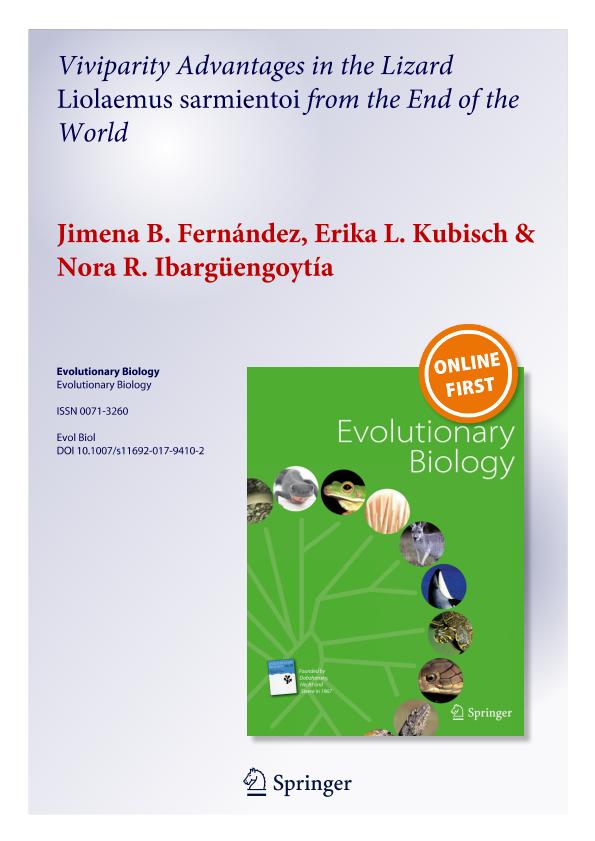Mostrar el registro sencillo del ítem
dc.contributor.author
Fernandez, Jimena Beatriz

dc.contributor.author
Kubisch, Erika Leticia

dc.contributor.author
Ibarguengoytía, Nora

dc.date.available
2018-11-01T15:02:49Z
dc.date.issued
2017-09
dc.identifier.citation
Fernandez, Jimena Beatriz; Kubisch, Erika Leticia; Ibarguengoytía, Nora; Viviparity Advantages in the Lizard Liolaemus sarmientoi from the End of the World; Springer; Evolutionary Biology; 44; 3; 9-2017; 325-338
dc.identifier.issn
0071-3260
dc.identifier.uri
http://hdl.handle.net/11336/63432
dc.description.abstract
Two hypotheses have prevailed to explain the evolution of viviparity in reptiles: the first proposed that viviparity evolved in response to cold-climates because the possibility of pregnant females to thermoregulate at higher temperatures than embryos could experience in a nest in nature. The second hypothesis posits that the advantage of viviparity is based on the possibility of females to maintain stable body temperatures during development, enhancing offspring fitness. With the aim to contribute to understanding the origins of viviparity in reptiles, we experimentally subjected pregnant females of the austral lizard Liolaemus sarmientoi to two temperature treatments until parturition: one that simulated environmental temperatures for a potential nest (17–25 °C) and another that allowed females to thermoregulate at their preferred body temperature (17–45 °C). Then, we analysed newborn body conditions and their locomotor performance to estimate their fitness. In addition, we measured the body temperature in the field and the preferred temperature in the laboratory of pregnant and non-pregnant females. Pregnant females thermoregulated to achieve higher temperatures than the environmental temperatures, and also thermoregulated within a narrower range than non-pregnant females. This could have allowed embryos to develop in higher and more stable temperatures than they would experience in a nest in nature. Thus, offspring developed at the female preferred temperature showed greater fitness and were born earlier in the season than those developed at lower environmental temperatures. Herein, we show that results are in agreement with the two hypotheses of the origin of viviparity for one of the southernmost lizards of the world.
dc.format
application/pdf
dc.language.iso
eng
dc.publisher
Springer

dc.rights
info:eu-repo/semantics/openAccess
dc.rights.uri
https://creativecommons.org/licenses/by-nc-sa/2.5/ar/
dc.subject
Evolution of Viviparity
dc.subject
Locomotor Performance
dc.subject
Pregnant Females
dc.subject
Thermoregulation
dc.subject
Viviparity Hypotheses
dc.subject.classification
Otras Ciencias Biológicas

dc.subject.classification
Ciencias Biológicas

dc.subject.classification
CIENCIAS NATURALES Y EXACTAS

dc.title
Viviparity Advantages in the Lizard Liolaemus sarmientoi from the End of the World
dc.type
info:eu-repo/semantics/article
dc.type
info:ar-repo/semantics/artículo
dc.type
info:eu-repo/semantics/publishedVersion
dc.date.updated
2018-10-23T16:15:54Z
dc.identifier.eissn
1934-2845
dc.journal.volume
44
dc.journal.number
3
dc.journal.pagination
325-338
dc.journal.pais
Alemania

dc.journal.ciudad
Berlin
dc.description.fil
Fil: Fernandez, Jimena Beatriz. Consejo Nacional de Investigaciones Científicas y Técnicas. Centro Científico Tecnológico Conicet - Patagonia Norte. Instituto de Investigaciones en Biodiversidad y Medioambiente. Universidad Nacional del Comahue. Centro Regional Universidad Bariloche. Instituto de Investigaciones en Biodiversidad y Medioambiente; Argentina
dc.description.fil
Fil: Kubisch, Erika Leticia. Consejo Nacional de Investigaciones Científicas y Técnicas. Centro Científico Tecnológico Conicet - Patagonia Norte. Instituto de Investigaciones en Biodiversidad y Medioambiente. Universidad Nacional del Comahue. Centro Regional Universidad Bariloche. Instituto de Investigaciones en Biodiversidad y Medioambiente; Argentina
dc.description.fil
Fil: Ibarguengoytía, Nora. Consejo Nacional de Investigaciones Científicas y Técnicas. Centro Científico Tecnológico Conicet - Patagonia Norte. Instituto de Investigaciones en Biodiversidad y Medioambiente. Universidad Nacional del Comahue. Centro Regional Universidad Bariloche. Instituto de Investigaciones en Biodiversidad y Medioambiente; Argentina
dc.journal.title
Evolutionary Biology

dc.relation.alternativeid
info:eu-repo/semantics/altIdentifier/doi/http://dx.doi.org/10.1007/s11692-017-9410-2
dc.relation.alternativeid
info:eu-repo/semantics/altIdentifier/url/https://link.springer.com/article/10.1007%2Fs11692-017-9410-2
Archivos asociados
